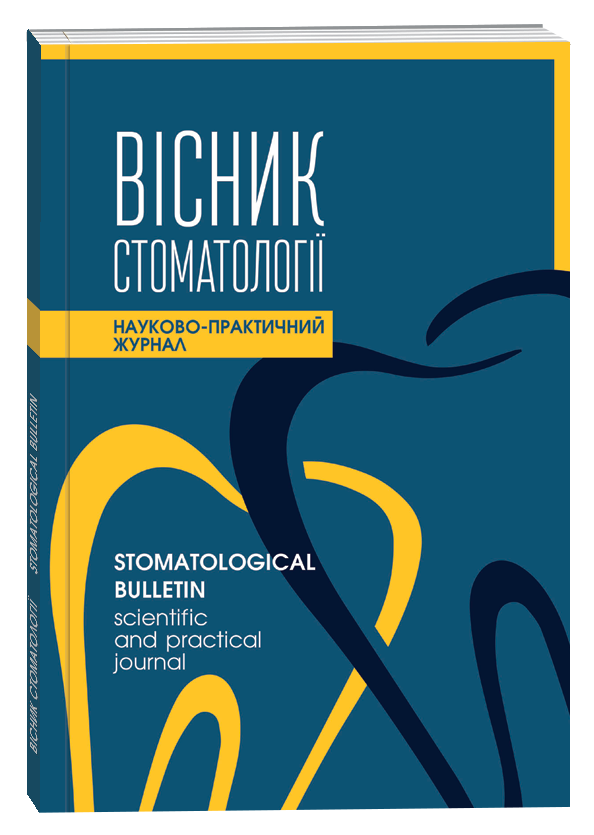IRRITATION FIBROMA OF THE ORAL MUCOSA: CLINICAL AND MORPHOLOGICAL FEATURES, RISK OF MALIGNANCY
DOI:
https://doi.org/10.35220/2078-8916-2023-50-4.6Keywords:
irritation fibroma, oral mucosa, reactive proliferative lesion, pathohistological diagnostic, risk of malignancy, laser surgery.Abstract
Irritation fibroma of the oral mucosa is a reactive proliferative lesion that result from persistent local irritation or mechanical damage to the mucosa. Purpose of the study. To determine clinical and morphological features of oral irritation fibroma in patients of different sex and age. Research methods. For the period of 2020-2023, 19 people with irritation fibroma aged 25 to 72 years were examined. In 12 patients, fibroma was removed by conventional surgery, in 7 patients – using a high-intensity diode laser. Pathohistological examination of biopsy material was carried out. Results. It was found that irritation fibroma is most common in middle-aged and elderly people, over 45 years old (84.2 %). The average age of patients was 56.9±2.7 years. Among patients with irritation fibroma, women dominated (68.4 %). Clinical studies have shown that chronic mechanical trauma was the cause of fibroma in all cases. By localization, fibroma is most often found on the tongue (36.8 %) and on the cheek (26.3 %), as well as on the lower lip (21.1 %) and on the alveolar process or gingiva (15.8 %). The average size of the irritation fibroma by diameter was 0,87±0,07 cm. According to the results of the pathomorphological study, it was found that all biopsies are hyperplastic fibrous formations of varying degrees of maturity and inflammation. Some irritation fibromas had morphological features that are characteristic of formations with the likelihood of degeneration into a malignant tumor. Therefore, by analogy with chronic traumatic ulcer, they can be classified as an optional precancer with a low risk of malignancy. Conclusions. Irritation fibroma is most common in people over 45 years of age, mainly in women and localized in most cases on the tongue and cheeks. Oral irritation fibroma for some morphological features may have a risk of malignancy.
References
Naderi, N.J., Eshghyar, N., & Esfehanian, H. (2012). Reactive lesions of the oral cavity: A retrospective study on 2068 cases. Dent Res J (Isfahan), 9(3), 251-255. PMID: 23087727
Kadeh, H., Saravani, S., & Tajik, M. (2015). Reactive hyperplastic lesions of the oral cavity. Iran J Otorhinolaryngol, 27(79), 137-144. PMID: 25938085
Farynowska, J., Błochowiak, K., Trzybulska, D., & Wyganowska-Świątkowska, M. (2018). Retrospective analysis of reactive hyperplastic lesions in the oral cavity. Eur J Clin Exp Med, 16(2), 92-96. http://dx.doi.org/10.15584/ejcem.2018.2.2
Cohen, P.R. (2022). Biting fibroma of the lower lip: A case report and literature review on an irritation fibroma occurring at the traumatic site of a tooth bite. Cureus, 14(12), e32237. doi: 10.7759/cureus.32237
Wakami, M., Kuyama, K., Sun, Y., Morikawa, M., Aida, M., & Yamamoto, H. (2012). So-called “denture fibroma”: A histopathological and immunohistochemical study. J Hard Tissue Biology, 21(3), 279-284. https://doi.org/10.2485/jhtb.21.279
Canger, E.M., Celenk, P., & Kayipmaz, S. (2009). Denture-related hyperplasia: a clinical study of a Turkish population group. Braz Dent J, 20, 243-248. https://doi.org/10.1590/S0103-64402009000300013
Kafas, P., Upile, T., Stavrianos, C., Angouridakis, N., & Jerjes, W. (2010). Mucogingival overgrowth in a geriatric patient. Dermatol Online J, 16(8). https://doi.org/10.5070/D399z2d3tc
Barker, D.S., & Lucas, R.B. (1967). Localised fibrous overgrowths of the oral mucosa. Br J Oral Surg, 5(2), 86-92. https://doi.org/10.1016/S0007-117X(67)80031-3
Toida, M., Murakami, T., Kato, K., & et al. (2001). Irritation fibroma of the oral mucosa: a clinicopathological study of 129 lesions in 124 cases. Oral Med Pathol, 6(2), 91-94. https://doi.org/10.3353/omp.6.91
Bouquot, J.E., & Gundlach, K.K. (1986). Oral exophytic lesions in 23,616 white Americans over 35 years of age. Oral Surg Oral Med Oral Pathol, 62(3), 284-291. https://doi.org/10.1016/0030-4220(86)90010-1
Rivera, C., Droguett, D., & Arenas-Márquez, M.-J. (2017). Oral mucosal lesions in a Chilean elderly population: A retrospective study with a systematic review from thirteen countries. J Clin Exp Dent, 9(2), 276-283. doi: 10.4317/jced.53427
Fomete, B., Agbara, R., Adeola, D.S., & Osunde, D.O. (2019). Inflammatory and reactive lesions of the orofacial region in an African tertiary health setting. Sahel Med J, 22(2), 96-101. DOI: 10.4103/smj.smj_35_17
Omisakin, O.O., Ogunsina, M.A., Yusuf, N., Zubairu, R.A., & Ayuba, I.G. (2021). Irritation fibroma of the oro-facial region: a retrospective study of cases treated in a Teaching Hospital in North-West, Nigeria. Nig J Res Orofac Infect Oncol, 4(1-2), 15-19.
Halim, D.S., Pohchi, A., & Pang, E.E. (2010). The prevalence of fibroma in oral mucosa among patient attending USM dental clinic year 2006-2010. The Indonesian J Dent Res, 1(1), 61-66. https://doi.org/10.22146/theindjdentres.9991
Nakamura, F., Fifita, S.F., & Kuyama, K. (2005). A study of oral irritation fibroma with special reference to clinicopathological and immunohistochemical features of stromal spindle cells. Int J Oral-Med Sci, 4(2), 83-91. https://doi.org/10.5466/ijoms.4.83









